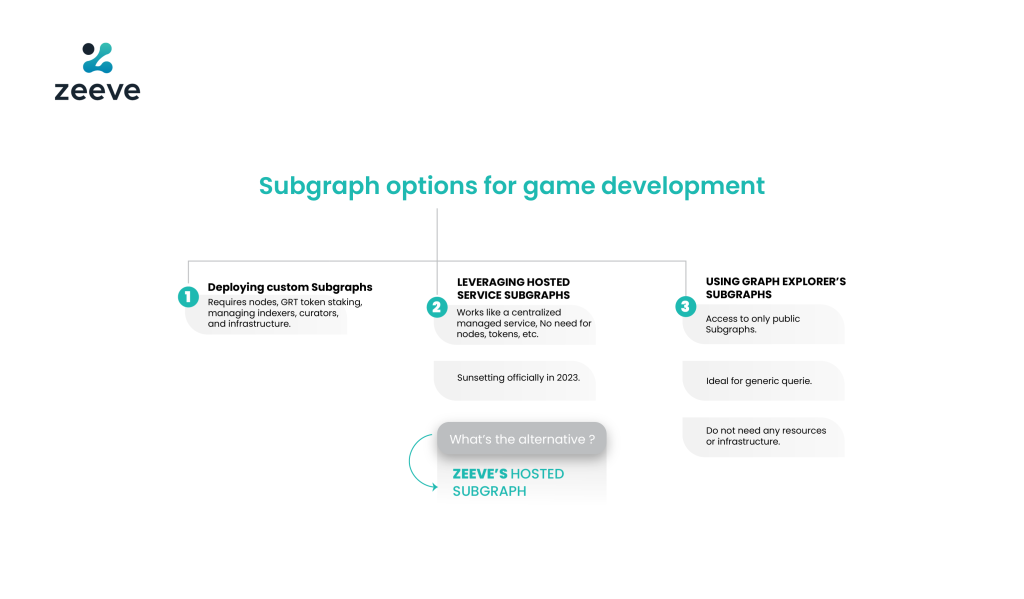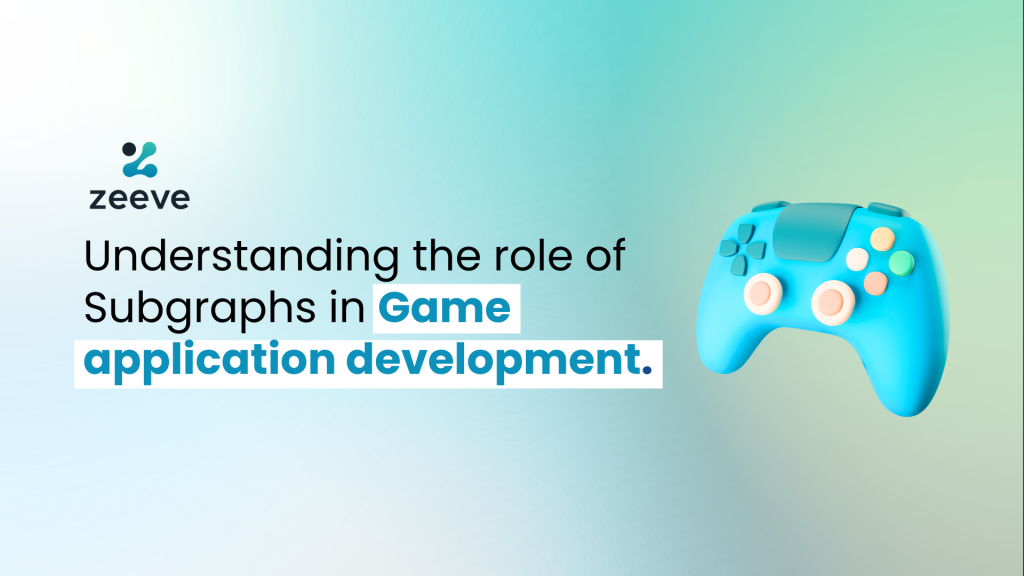Having access to specific and adequate amounts of data is vital for game application development. Data makes a game more functional, improves its design, identifies difficulties, and ultimately increases the user base. Subgraphs, powered by the Graph Protocol, are an excellent solution for indexing bulks of blockchain data and enabling smooth querying, allowing the creation of a robust, highly engaging, and feature-rich game.
If you are an enterprise or individual project building a game application, this guide provides a detailed overview of using Subgraphs for gaming apps development. We will explore Subgraphs, type of data it indexes for games, how to use it, use cases, and more.
What type of data gaming applications need to index using Subgraphs?
Below are the main types of blockchain data that gaming applications index from Subgraphs to create the best player experience:
- Characters and art details: Gaming applications use Subgraph to process unfiltered blockchain data and retrieve specific characters and art details, such as their unique characteristics, rewards, possession of assets, level unlocked, and activities.
- Digital asset ownership and transferability: With smart contract reads, you can extract basic information from blockchain, such as the age of certain characters or getting their content URI through ID. Whereas, you cannot query specific data, total assets and ownership type by characteristics. Subgraph indexes of all kinds of data– trivial or non-trivial– allowing gaming applications to query the indexed data via GraphQL calls.
- Historical and real-time transaction data: Subgraph indexes bulk historical and real-time transaction data while allowing gaming applications to extract the necessary data for displaying on their game’s interface.
- Fetching token balances: Using Subgraphs, your gaming application can aggregate all types of tokens, be it ERC-20 (fungible token), ERC-721 (NFT or non-fungible token), ERC-1155 (semi-fungible tokes), or any other nature of token from player’s accounts and show the aggregated data on the interface.
- Community and governance-related data: By querying data related to on-chain governance, such as members’ votes on a specific proposal or changes to the platform’s rules, gaming applications can make informed decisions and improve their governance to make it more player-centric.
Challenges of data indexing in game development
Following are the blockchain data indexing challenges that game application developers may come across:
1. Data extraction complexity:
For Gaming applications, extracting data from blockchain’s large and unorganized databases is very hard. Let’s say you want to query data from Axie Infinity, which game has 2.8 million daily active players- you first need to pull raw data via RPCs and filter it based on your project’s needs. This process is time, resource, and engineering-intensive s at the same time.
2. Complexity of Setting up infrastructure:
The traditional means of extracting blockchain data– whether RPCs or APIs– require you to set up heavy data servers, self-hosting of RPC node, APIs, clients, and specialized hardware and software resources to maintain the whole infrastructure. Setting up all such infrastructure for data extraction is definitely a complex task.
3. Inaqueduate data flow:
Gaming applications are committed to maintaining data flow, ensuring a great player experience despite their huge and constant userbase. However, data retrieval blockchain data through RPC and APIs cannot ensure 100% adequate data flow and standard query speed. This causes interruption to the players and, meanwhile, limits the game’s features and capabilities.
4. Data supply outage:
The server-based data indexing requires constant maintenance and updates. For example, if a game application has to do any modification its data indexing servers, the data supply can be down, ranging from few minutes to hours, which will obviously impact the game and its players’ experience.
5. Parallel data querying:
To build a competitive, new-age game application, you need to extract and utilize data from more than one blockchain. For example, you can host a game tournament or virtual events that need to track data on multiple networks. Doing this is easier through ‘parallel’ data indexing, which requires you to set up multiple servers and infrastructures to manage them, along with hardware and technical resources.
Subgraph’s solution to bypass the above challenges
- Faster data indexing and filtering:
Despite the growing user base and frequent fluctuation in data, Subgraphs for gaming apps ensures fast indexing of all types of data with the highest volume of up to 30,000,000+ monthly queries. This is done through hundreds of indexers parsing the unprocessed blockchain data and modifying it in a readable format. - Option to choose managed service:
The Graph offers Hosted Services, which is an alternative to the hassle of setting up infrastructure or getting the hardware requirements. It’s a low-cost, production-ready infrastructure where you can deploy gaming Subgraph and only pay for queries. However, this service will shut down by 2023. - Consistent, 24/7 data flow:
Subgraphs on the Graphs network are optimized to keep data on your gaming applications flowing 24/7 without needing any backup servers or extensive resources.
- Superior uptime and performance:
The Graph network ensures 99.99% uptime for your gaming application, eliminating any chances of downtime or interruption in data supply. All your queries will be served reliably and instantly. - Seamless management of multiple Subgraphs:
Whether you opt for The Graph’s decentralized network or the hosted service, you can create and manage a range of Subgraphs to serve the need for unique data indexing. Plus, all your Subgraphs will equally offer fast data indexing and retrieval.
How game applications can query data from Subgraphs?
Game applications can index and query data using Subgraph in the following three main ways:
- The Graph’s Subgraphs for gaming apps allows for creation of custom Subgraphs and their deployment to Graph’s decentralized network. To do this, you need to build a smart contract, get GRT tokens, a crypto wallet, and hardware/software resources.
- The Graph’s Explorer offers a range of gaming Subgraphs built and published by Subgraph developers. If your game’s data aligns with any of these subgraphs, you can query the indexed data and use it for your game development.
- Hosted Service Subgraph is a Graph-managed service that allows web3 applications to deploy and use Subgraphs without needing GRT tokens, run nodes yourself, or get curators and indexers. However, this service will be shutting down completely in 2023. Knowing this, web3 projects are migrating their Subgraphs to the Graph’s decentralized network or opting for third-party Hosted Subgraph services.

Want to learn more about how web3 applications can query data using Subgraph? Refer to our in-depth guide linked below:
How to query Web3 data using The Graph Protocol and Subgraphs
Popular Gaming Subgraphs deployed on the Graph protocol
Knowing that subgraphs are the greatest and most feasible way to index and query web3 data, various gaming subgraphs have been deployed on The Graph network. Decentraland marketplace subgraph, Reboot gaming, Aavegotchi Subgraph, Decentral Games DG, Axolittles, and Nifty league are some of the popular names that are querying a range of blockchain data such as asset ownership records, token balances, and rewards.
Try Zeeve’s hosted Subgraph service for your gaming application
Zeeve offers a highly optimized, enterprise-grade data indexing infrastructure to deploy your Subgraphs with low cost, superior performance, scalability, and security with ISO 27001 and SOC 2 Type 2 compliance.
Based on your game-specific needs, you can deploy shared or dedicated indexers via our low-code platform with no need to set up infrastructure, manage graph nodes, or pay in GRT tokens– simply perform queries through an economical, per-subgraph pricing model. You can deploy a new Subgraph or migrate from Graph’s hosted service to Zeeve because that is soon sunsetting.
Also, Zeeve can assist you in building a Subgraph from scratch for your dApp. For more information on how Zeeve simplifies Subgraph development and maintenance, please contact our blockchain experts. Drop your queries via email on this page, or you can also schedule a one-on-one call with our consultants.





